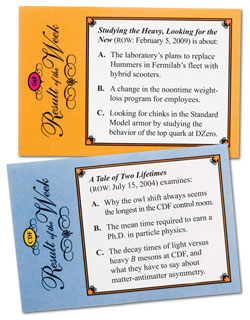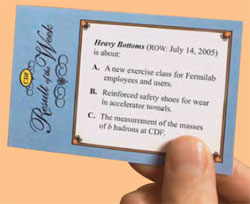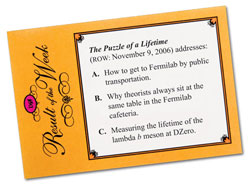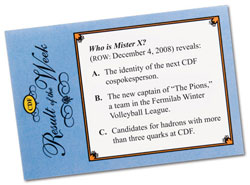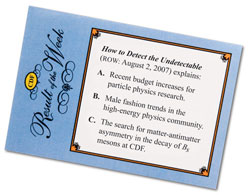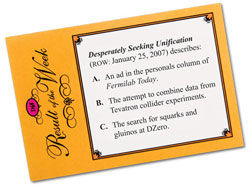Result of the week
Behind every big breakthrough is a series of small steps that build on each other to enhance our understanding of the universe. At Fermilabs Tevatron Collider, physicists have been telling the unfolding story of their experiments in weekly installments for more than five years.
By Judy Jackson
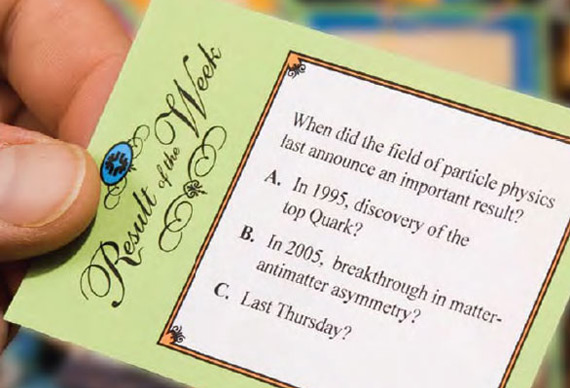 |
|
| Photos: Reidar Hahn, Fermilab | |
Quick. When did the field of particle physics last announce an important result? Was it:
- In 1995, discovery of the top quark?
- In 2005, a breakthrough in matter-antimatter asymmetry?
- Last Thursday?
Insofar as particle physics has a popular image, it is one of a field that produces occasional blockbuster discoveries–a new quark, a fresh force of nature–separated by long stretches where nothing much happens but theoretical speculation. Picture hundreds of caffeinated physicists hunched over their computers for decades while they wait for their experiments to disgorge a Higgs boson or an extra dimension of space.
In fact, something closer to the opposite is true. Week by week, year by year, those hundreds of experimental physicists are at work systematically filling in the blanks and connecting the dots between marquee discoveries. Using the data from trillions of particle collisions, they are incrementally building the understanding of the laws of nature, result by precision result.
Jacobo Konigsberg, a University of Florida physicist and co-spokesperson of the Collider Detector at Fermilab experiment, or CDF, likens the process to archaeology, to uncovering an unknown civilization shard by shard. "These are precision results that improve our knowledge of nature," he says. "We find a new piece, and then another, until eventually they fit together. Or its like deciphering an unknown alphabet. We are trying to decode the most ancient language nature uses."
Week by week, result by result, Fermilab Today chronicles their progress. Every Thursday for more than five years–with a couple of weeks off each year for Christmas–Fermilabs daily electronic newspaper has published a new Result of the Week from the laboratorys Tevatron collider experiments, CDF and DZero. Written by the experimenters themselves, in language resembling plain English, these 250-odd Results tell the story of an unfolding understanding of particle physics–and of the physicists who do it.
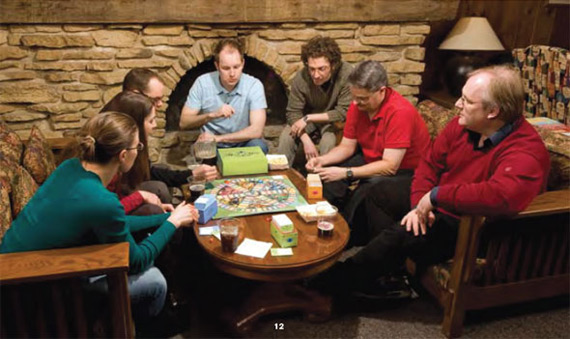 |
| From left: Result of the Weeks Alison Lister, Robin Erbacher, and Craig Group of CDF and Wade Fisher, Aurelio Juste, Don Lincoln, and Stefan Soldner- Rembold of DZero. Juste and Soldner- Rembold are contributors; the others are past or current editors. Not pictured: former editors Ben Kilminster of CDF and Paul Padley of DZero. |
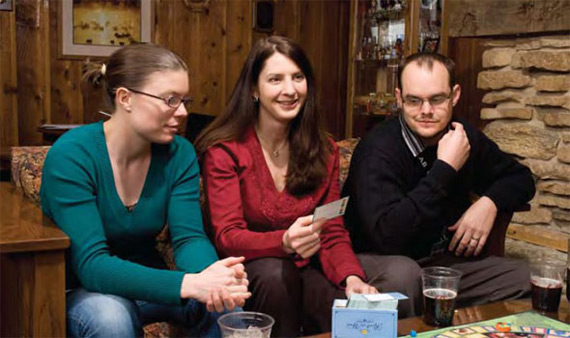 |
Black orchids and firecrackers
Results have covered the spectrum of particle physics topics: leptoquarks, pomerons, tau leptons, top quarks, single top quarks, mesons by the dozens, matter-antimatter asymmetry, W bosons, Z bosons, charm quarks, strange quarks, bottom quarks, electrons, the strong force, the weak force, and multiple searches: for supersymmetry, for dark matter, for extra dimensions, and for the Higgs boson, to cite only a few.
Results often have attention-grabbing headlines–"An illicit interaction," "Why antimatter does not matter," "The black orchids of particle physics," "Tautal excess," "Discover one, get three free," "Weighing a firecracker"–and they make liberal use of metaphor: Bumps in the night. Romeo and Juliet. The parton patrol. The road less traveled. A weight problem. An identity crisis. Theyve all been pressed into service to bring Results to life for ordinary readers. "If science were like dating, then the search for that special particle might start with a personal ad " begins a Result on the search for charged massive stable particles.
When Fermilab computer scientist Ruth Pordes first proposed a weekly feature to highlight Fermilabs Tevatron experiments, many at the laboratory had doubts. Hugh Montgomery, now Jefferson Laboratory director, then Fermilabs associate director for research, snorted when he heard the proposal. Montgomery and other skeptics had a hard time believing the experimenters would take the time and trouble to write up new experimental results in non-technical terms, 50 times a year, for public consumption.
The skeptics reckoned without the well-developed spirit of competition between the two experiments.
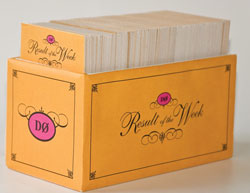 |
Ready and willing
DZeros Paul Padley, a Rice University physicist, was eager to begin. He had already created a DZero Web page for the public, and he was delighted at a further opportunity to showcase his experiments results.
"The Run II upgrades to the CDF and DZero detectors had just been severely scaled back," Padley says, "and I wanted to counter the feeling of negativity. Whatever difficulties we had at the Tevatron experiments, we still had the highest energy in the world, and we were operating at the cutting edge. I felt we should be celebrating."
The DZero spokespeople wasted no time in putting Padley in charge of editing and submitting the collaborations Result of the Week. With DZero ready and willing, could CDF be far behind? After a brief attempt to craft their collaborations weekly submissions themselves, the CDF spokespeople appointed Robin Erbacher, then a Fermilab physicist, now associate professor of physics at the University of California, Davis, to the job. Like Padley, Erbacher had a passion for communicating to non-experts the esoteric science she had chosen as her lifes work.
"I took a science-writing class in college," Erbacher says. "I was a writing minor, but more literary writing. I didnt have much practice in science writing. It helped that I was a tour guide at SLAC. I had given a few public lectures. I just jumped in."
The launch
So did Fermilab Today. On Thursday, September 18, 2003, the publication presented the first Result of the Week with this introduction:
"Fermilab Result of the Week
Today, Fermilab Today launches a new feature. Each Thursday, Fermilab Today will bring readers a new scientific result from ongoing research at Fermilab. Todays inaugural story features two results, one from CDF and one from DZero, both focusing on the fascinating search for extra dimensions beyond the familiar three of space and one of time. Future Thursdays will bring more forefront results from the collider collaborations as well as from neutrino experiments, astrophysics and accelerator physics research."
By the next Thursday, DZero was ready with "Hunting for Higgs Has Begun." The following week, CDF countered with "CDF Observes Mystery Meson." They were off, and they never looked back.
In fact, while Fermilab Todays editors had originally intended to include results from other Fermilab experiments, the collider experiments soon came to own the upper right-hand corner of Thursdays edition. When offered a weeks holiday to make way for a result from an astrophysics group, far from gratitude for a weeks respite, the collaborations expressed outrage: Hell no! If they have a result, let them get their own day.
Keeping it simple
The format for the Result of the Week is simple. Each submission features a plain-English explanation of a single new "blessed" result: one approved by the collaboration to be shown in public, although perhaps not yet published. The explanation includes the reason why the result is interesting and significant, a graph or other illustration, and the photographs of those most directly responsible for the result. It sounds straightforward, but it took time for the author-editors to hit their stride.
"At first I put in more technical detail," says CDFs Erbacher. "Later, I realized that, unless the result speaks for itself, the actual number doesnt matter as much as what it means. Invariably I would remove at least one sentence that the authors thought was crucial but meant nothing to the general reader. I couldnt put it in, even though the authors wanted it."
DZeros Padley agrees.
"I knew it would be a struggle to convince colleagues that the public doesnt care about the number," he says. "That struggle never went away. I could anticipate having that discussion just about every time. The public are happy for you that you got the number, they are interested to know what it means, but of itself it doesnt convey anything. The public doesnt really care about the numerical result, while to physicists, the number is everything."
CDF physicist Ben Kilminster, who took over as the collaborations Result of the Week editor in 2005, says making clear why a result matters is what matters.
"Especially if its a brand-new result, its good to take a step back and ask Why is it significant?" he says. "That seems to me the real reason why the Result of the Week is important."
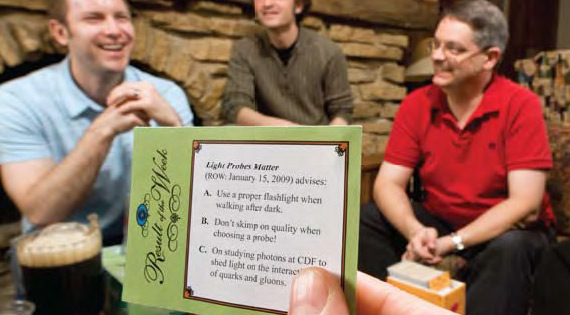 |
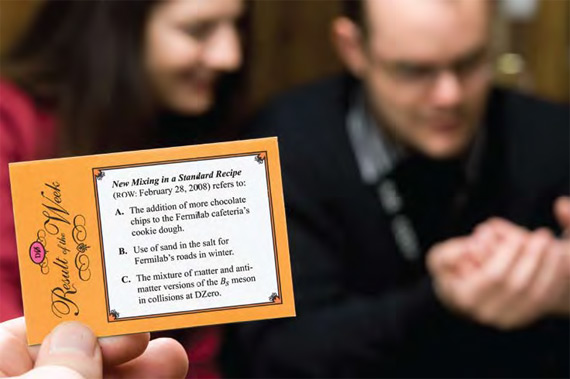 |
Everyone wants in
All five past and present Result of the Week editors say they have tried to feature mostly new results, rather than simply more precise values of previous measurements. From the start, theyve had plenty to choose from. The problem was how to decide among them.
In a collaboration of hundreds of scientists, the Result of the Week offered one way to stand out from the crowd.
"It quickly got to the point where people were fighting to get their results chosen as the Result of the Week," Padley says. "A Result of the Week can be very useful when youre a tenure-track professor at a university."
Fermilab physicist Rob Roser, CDF co-spokesperson, says experimenters are eager to have their work featured because they perceive that the Result of the Week is widely read. "Its a challenge to find ways to get peoples work recognized," Roser says. "The Result of the Week is one of the few places we can do this."
Northeastern University physicist Darien Wood, DZero co-spokesperson, agrees. "Print-outs of the Result of the Week get posted on bulletin boards in collaborators home institutions," he says.
If the Result of the Week pays off for physics groups, it also rewards its editors, according to experiment spokespersons and the editors themselves. They have the collaborations gratitude and an unparalleled view of the experimental landscape, says CDFs Konigsberg.
"The person who writes the Result of the Week gets lots of credit," he says. "They meet everybody and get lots of exposure. They become very well versed in all the realms of the experiment. They learn about everything. They know more about top, supersymmetry, new particles, the B sector, wherever we are pushing the boundaries and finding things. They have a great overview of the landscape were exploring."
The individual touch
In April 2007, Padley handed off the DZero editorship to Fermilab physicist Wade Fisher. Fisher says Result of the Week selections usually come from the experiments spokespeople and physics coordinators. He meets with DZeros leaders every couple of months to choose the roster of upcoming topics, selected from detector groups or as the lead-up to an upcoming physics conference. Or, perhaps, for a different reason: "When CDF has a big result," he says, "sometimes well do a counterpunch."
Physicist John Womersley, now director of Britains Science and Technology Facilities Council Science Programme, was co-spokesperson of DZero at the launch of Result of the Week, and he remains a fan. One of the reasons it works, he believes, is that the collaborations produce the Results themselves, rather than relying on science writers, however skillful.
"You can tell that different people worked on them, because the voices of the individual scientists come through, because they are written by the scientists themselves," Womersley says. "Big experiments tend to blandify everything by presenting a standard view in standard language. The Result of the Week is a reminder that the results come from small groups, not from 500 people sitting down in a conference hall but from five people sitting down at a table. Theyre a reminder that results are not factory produced but individually crafted. It makes the science seem less corporate. In a way, the Result of the Week sets a higher standard than a journal paper, because it forces the experimenters to think about why an individual result is interesting."
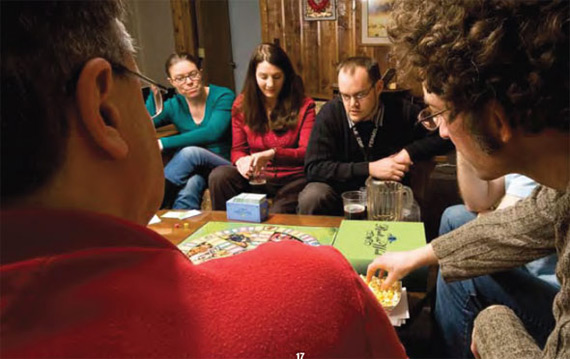 |
Click here to download the pdf version of this article.



